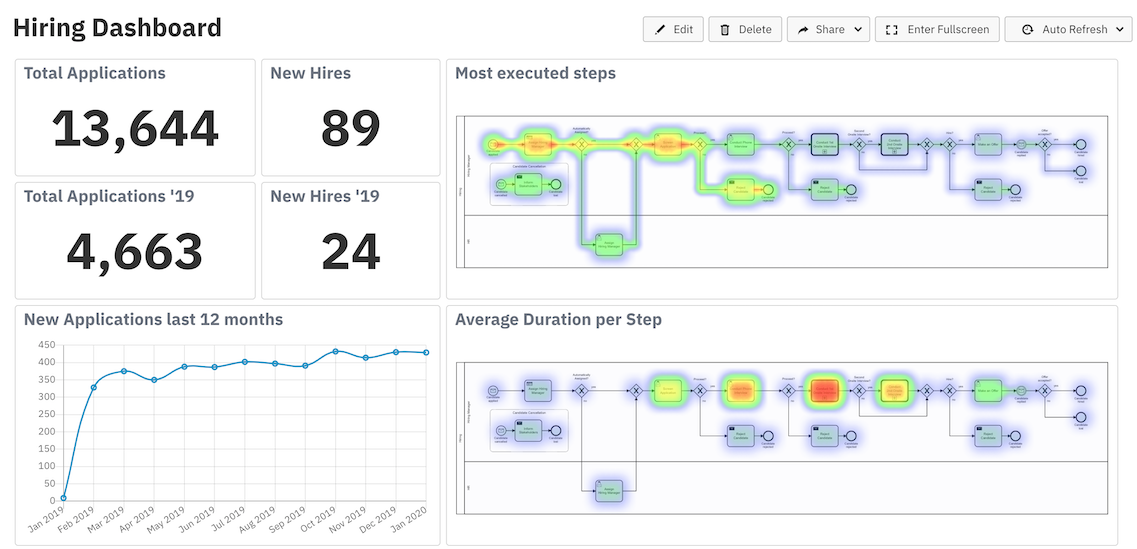Camunda
About Camunda
Camunda Pricing
https://camunda.com/pricing/
Starting price:
$99.00 per month
Free trial:
Available
Free version:
Available

Most Helpful Reviews for Camunda
1 - 5 of 12 Reviews
Jose
Verified reviewer
Computer Software, 1,001-5,000 employees
Used weekly for more than 2 years
OVERALL RATING:
5
EASE OF USE
5
VALUE FOR MONEY
5
FUNCTIONALITY
5
Reviewed December 2022
Camunda, an excellent solution for business automation, standardization and process improvement.
Camunda is an exceptional tool, its modeler is excellent and allows you to radically reduce development and implementation times. Camunda's workflow engine executes the processes that are designed in standards such as BPMN, which is considered the most widely used standard for process modeling for business and process systems.
PROSOne of the biggest advantages of Camunda is its flexible framework, specially designed for the automation of workflows and decisions through standards such as BPMN and DMN, widely known by process analysts, in addition to its infinite capacity to create integration with other applications in the market. Additionally, it has a set of easy-to-implement tools to apply own or third-party task lists, with programmatic control of the life cycle and generation of traceability in the process.
CONSIts learning curve is fast, there is a large amount of documentation on the market that allows us to speed up the implementation process, in addition to the fact that there are developments available that can be taken as an example or starting point for our parameterizations. On the other hand, it has been used a lot and is kept up to date, with a community that collaborates in improvements and in the generation of new integrations.
Reasons for switching to Camunda
Many more existing developments around Camunda, and the ability to perform more integrations with applications currently deployed in the organization.
Anonymous
5,001-10,000 employees
Used weekly for more than 2 years
OVERALL RATING:
5
EASE OF USE
5
VALUE FOR MONEY
4
CUSTOMER SUPPORT
4
FUNCTIONALITY
5
Reviewed January 2023
Camunda - easier way to manage your workflow with underlying system
I am fully satisfied after using this siftware. Any kind of workflow that you need to design to get connected from Northbound with south bound system through API integration its much easier
PROSThe graphical presentation, handling workflow during runtime and tracking it much simplistic way- you do not have to be a pro in this software, even novish can handle it
CONSMight be UI part can be improved a little bit to make more user-friendly
Reasons for switching to Camunda
Camunda is user firendly and ease to handle. The UI is easy to learn as well.
Gabriel
Verified reviewer
Outsourcing/Offshoring, 201-500 employees
OVERALL RATING:
4
EASE OF USE
4
VALUE FOR MONEY
1
CUSTOMER SUPPORT
4
FUNCTIONALITY
5
Reviewed November 2023
Very expensive tool specifically built for JAVA ecosystems
We used the platform as a solid BPMN workflow automation tool, even though it can do a lot more. The business users were extremely hyped by the modeler tool (that allows them to simply build workflows by drag& dropping blocks & liking them together in a logical sequence). The Cockpit module (in version 7) and the Operate module (in version 8) were also extremely appreciated since they provided a nice insight into the actual execution of the workflow instances. However, setting up a Camunda 8 instance in the cloud was a painful process - In general, the platform is a resource hog, and we did not appreciate the way it enforces the use of keycloak and postgres. As a further downside, there is very little relevant documentation on how to deploy it in Azure - we had to do a lot of digging, so the whole setup process took about 180 man-hours. Once this was done, we managed to create a proof of concept in which to link workflow blocks to other applications, and to use the .net-connector plugin to write custom implementations for some of the blocks. However, in the end we had to drop the whole thing because the Operate module was only available under the licensed version - which meant a 50k USD/year fee.
PROS- We loved the modeler, we also loved the fact that deploying the platform in a dev environment was extremely easy (docker based). - We also liked the cockpit module, that allows to easily track what happens to a workflow execution. - We liked that the platform sticks with the BPMN standard implementation. - We also liked that the platform is offered both for Self Hosting (e.g. in a K8 cluster) or as SaaS (within their own cloud platform)
CONS- The cost was prohibitive for small to medium companies. They start with a flat rate of 50k USR/year, to which they add hosting costs when using the SaaS option. - In version 7, parallel jobs simply do not work. In version 8 they do, but in v8 the cockpit (operate) module is no longer available under the free license. - The whole platform is written in JAVA and this is also apparent in all integrations.
Anonymous
51-200 employees
Used monthly for more than 2 years
OVERALL RATING:
5
EASE OF USE
3
VALUE FOR MONEY
5
CUSTOMER SUPPORT
3
FUNCTIONALITY
5
Reviewed February 2024
The Industry standard BPMN platform
Brilliant as an open source tool if your team has the expertise to tailor it to your use case.
PROSThe ability to design powerful workflows using BPMN that can scale for businesses of any size
CONSThe learning curve is significant even for seasoned business process automation specialists. Hiring Camunda experts is expensive!
Bogdan
Information Technology and Services, 2-10 employees
Used daily for more than 2 years
OVERALL RATING:
5
EASE OF USE
4
VALUE FOR MONEY
5
CUSTOMER SUPPORT
5
FUNCTIONALITY
5
Reviewed August 2016
best open source process engine
We've been developing full-fledged BPM applications on the camunda engine for the past two years and we are continuously excited by the frequent and consistent updates the camunda team provide to the engine every six months.
PROSIt's open source, it's fully compatible with the BPMN, DMN, CMMN standards (so its models could be interchanged with other standard-compatible tools), the dev & support teams are incredible, it's very lightweight and very fast (which means it scales extremely well) and it has a great REST API interface. Plus it has one of the best modelers out there, free of charge.
CONSThis engine is a developer-friendly engine, which means you hook the engine to your own software solution in order to create a complete business app. So while it is perfect for developers, it is not suited for regular business users who still believe in the low-code / no-code myth.
